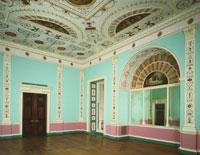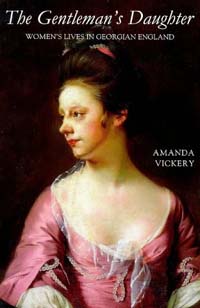Victoria here. I subscribe to a number of British publications — and always save them until I can sit down with a cuppa — and enjoy them without pressure. Needless to say, they pile up. The BBC History magazine for December 2010 had to wait until last weekend when my DH was immersed in football games. I had much more fun reading “All in the best possible Taste” on p. 42, which was written to accompany the BBC Two series At Home with the Georgians, presented by Amanda Vickery. Her book, Behind Closed Doors: At Home in Georgian England, was published in the U.S. by the Yale University Press in 2010.
Amanda Vickery is a professor of history at Queen Mary, University of London. While investigating the subject of taste, she discusses Lady Shelburne. Faithful readers of this blog will already be familiar with Lady Shelburne’s taste, as shown in her homes. Lansdowne House, London, and Bowood, in Wiltshire, were the topics here last March 29 and 31 and April 4, 2010. As Earl and Countess of Shelburne, William and Sophia established prominence in Georgian social and political circles. Later, after Lady Shelburne’s early death at age 25, the earl was named first Marquess of Lansdowne.
Amanda Vickery has specialized in matters domestic in her latest book as well as in her earlier work,The Gentleman’s Daughter: Women’s Lives in Georgian England, winner of the Longman History Today Prize in 1998. Marriage, child-bearing and housekeeping are described based on Vickery’s research into the letters and diaries of 18th and early 19th century women.
I am sorry to report that the BBC Two website does not have a replay available for the three-part series At Home with the Georgians. Why not, I’d like to know? Perhaps it will show up in one of those catalogues or PBS will run it.
Vickery, in the brief article in the December BBC History magazine, tells of the arranged marriage of William, Earl of Shelburne, and Lady Sophia Carteret in 1765 which blossomed into a true love match. Together they chose furnishings for their households, including paintings, decor, statuary and carpets.
Taste, in the prevailing view of their time and class, was based on classical themes, evidence of knowlege of the Greek and Roman civilizations. At right is the Adam Room in London’s Lansdowne Club, part of the former mansion belonging to the Shelburne/Lansdownes, as recently restored. Note particularly the elaborate ceiling design.
At left is the Shelburne/Lansdowne dining room as it was reconstructed in New York’s Metropolitan Museum of Art after the partial demolition in the 1930’s of the London house just off Berkeley Square. Shelburne was a rising Whig politician and the family homes were important arenas of social and political life in those days.
After the sad death of Lady Sophia (1745-1771), he married again. I suppose it was necessary to have a hostess to preside over these fine rooms!
Etruscan/Pompeiian designs. It was in rooms such as these that members of Britain’s ruling circles combined their discussions of pending legislation with the enjoyment of fine wines and elaborate meals, dancing, concerts, and cards.
The Shelburne/Lansdowne family also entertained at the Wiltshire property of Bowood, their principle country home not far from Bath. At left is the dining room from Bowood which is now the Board Room in the venerable Lloyds of London, occupying a place of honor in the otherwise extremely modern building in the City of London
.
The taste of the furnishings provided the proper setting for the establishment of national policy and thus had an important effect upon them.








